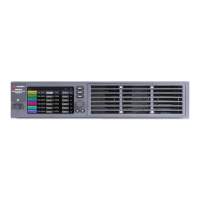Tables are initially created using the MEM:TABL:SEL command. Up to 30 tables can be created and
stored in volatile memory per mainframe. To save the tables when the instrument is turned off, copy
them to non-volatile memory using MEM:TABL:COPY. Up to 30 tables can be stored in non-volatile
memory per mainframe. The number of voltage or current points per table returned is set at 1024.
Specify the Compensation
Specify a compensation mode before programming the table. Refer to Compensation Modes for
details.
Note that changing the compensation mode turns the channel's output off.
Front Panel Menu Reference SCPI Command
Not available For initial turn-on and debug of SAS operation:
CURR:SAS:BWID "DEFAULT", (@1)
For DC to DC converter and MPPT applications with
≥20 μF external capacitance:
CURR:SAS:BWID "DCDC_20UF", (@1)
For Shunt Switching applications:
CURR:SAS:BWID "SHUNTSW", (@1)
Programming a New Table
If a table does not exist, you must program a new table. Programming a table consists of entering
voltage data and current data to create the desired number of I-V coordinate-pairs. The number of
voltage values must match the number of current values.
Front Panel Menu Reference SCPI Command
Not available To create a new a table for output 1:
MEM:TABL:SEL <"name">
To enter voltage and current data for the table:
MEM:TABL:VOLT 0,5,10,50,55,60
MEM:TABL:CURR 4,4,3.5,3,2.5,0
Select the Table
Select a table as follows:
Front Panel Menu Reference SCPI Command
Not available To select a table on output 1:
CURR:TABL:NAME <"name">, (@1)
Enable Table Mode
To enable Table mode:
Front Panel Reference SCPI Command
Not available To specify Table mode:
CURR:MODE TABL, (@1)
4 Using the Modular Power System
82 Keysight MP4300 Series Operating and Service Guide

